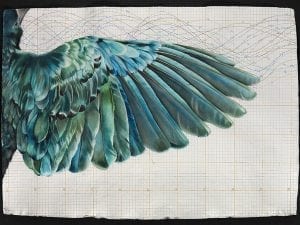Tamao Narukawa is a Japanese artist based in London. Her work takes a poetic approach, using metaphors and parables, creating a juxtaposition of humour and seriousness. She says: “Fact is transposed to fiction, fiction is transposed to fact. This seemingly paradoxical logic represents my vision.”
A: How does your work respond to the blurring lines between fact and fiction?
TN: Sometimes people get confused with what reality is. It exists around us so naturally we rarely question it. But from time to time we feel an unexpected discomfort and come to a sudden stop. Through noticing this, we can discover the underlying truth that fiction can be more “real” than we first though. I believe this fiction is the first step to the truth hidden in reality and allows emotions and actions we can’t put into words to emerge in an allegorical way.
A: What do you think is the value in undermining realities and creating new virtual constructs in terms of social and political engagements?
TN: Art may be no different to politics or society. As a system created by man, taking a broad view, these two can be considered as similar. Except for differences in creative output, art is just one part of society as a whole. Therefore, as something constructed by man, virtual creations have the same value as politics, etc. But creations that can’t be digitised or put into words require the receiver to make comparisons with their memories and experiences to understand, which makes it possible to touch a chord deep within.
A: Could you discuss the themes of your work – how you conceive an idea and bring it to life through video installation?
TN: Being an outsider for the past few years has led to my interest in others. Their body parts, memories, time and future inspires my video work. I have a constant flood of ideas, from when I’m having conversations to when I am sleeping, in other words, all day, everyday. I take notes so as to not forget these moments and accumulate them, even rough ideas that are faded in colour and abstract in shape.
These ideas can initiate good chemical reactions, unexpected in form and timing, for example when I was researching aboriginal history. This is a moment when the discomfort you feel day-to-day takes shape, and I value this. Film is a relatively new medium, compared to painting or sculpture, so I am interested in its ability. I believe it can influence others deeply.
A: Why do you think that homogenisation and globalisation are particularly relevant topics?
TN: This is from my experience in Morocco. I stayed in an old town which is called Medina for about a month. The locals I met there got their information through social media, listening to western music, and patching up old Nike trainer. This was not a place a tourist would visit. This third world country, after obtaining independence from France in 1956, tried to regain its lost Muslim identity but instead became westernised. At the moment I can’t decide whether this is a good or a bad thing but it is the reality of 2017 and I feel passionate about presenting this in my work.
A: How do you think that humour plays a role in your pieces and what this does in terms of audience connectivity and emotion?
TN: I feel confident in unique methods of expression. My original style of putting together humour and earnestness is inspired by the traditional Japanese narrative “Rakugo.” Tension and relief can strongly influence one’s mind and allows the recipient to truly understand, which leads them to having a psychological connection with my work.
A: What do you have planned in terms of future projects?
TN: I have an exhibition at Hochschule fuer Bildende Kuenste Hamburg, Germany in February. It’s a very important year for Germany as two historical art events, Documenta14 and Sculpture Projects Münster, take place in the same year. I am thrilled, to be able to create something during the big changes which are occurring in the world such as Brexit and the US election. There are insiders and outsiders everywhere, and so I would like to express what only outsiders can see.
Credits:
1. Courtesy Tamao Narukawa.





